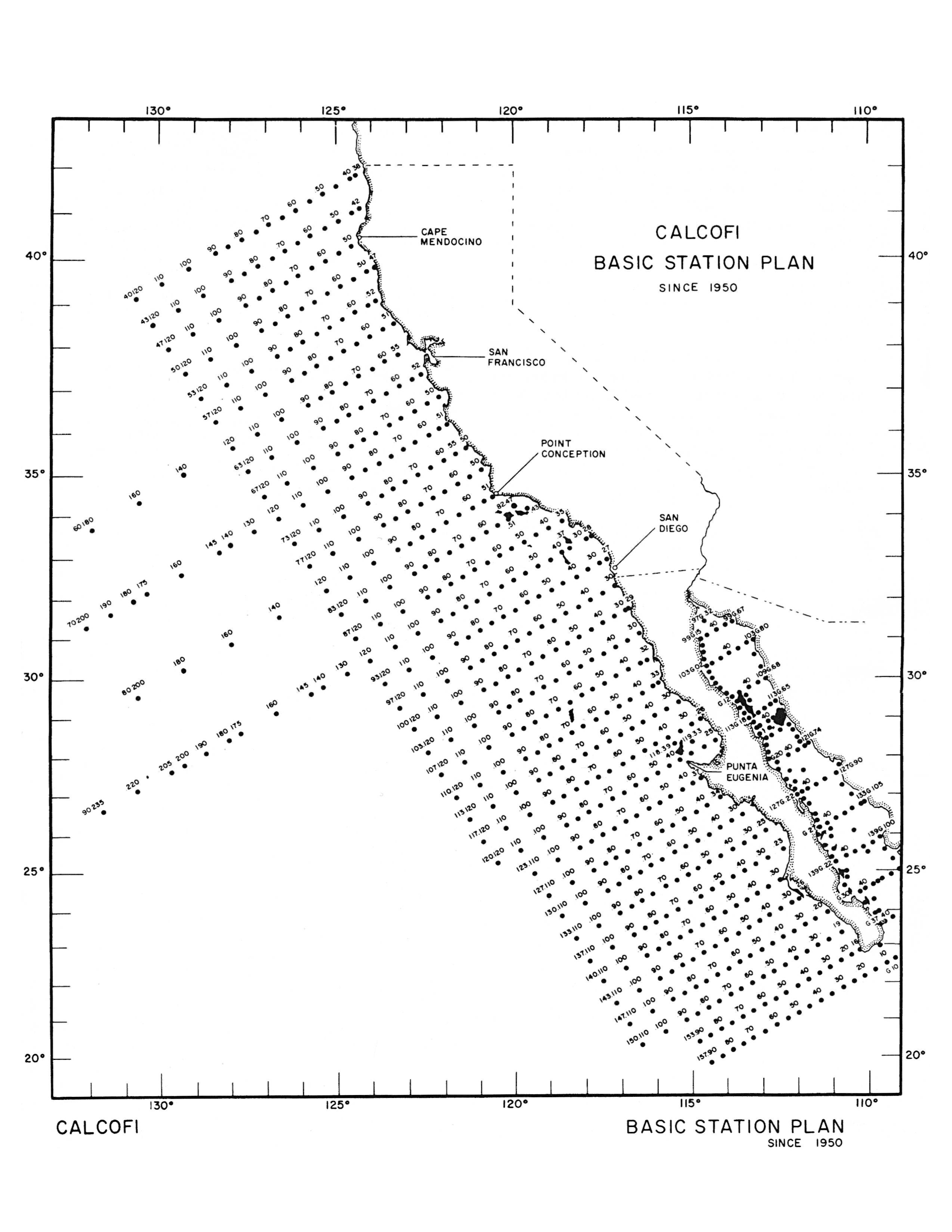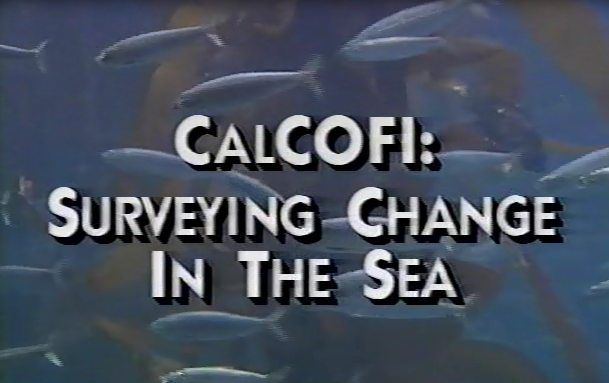The origin of CalCOFI through the decline of the Pacific sardine fishery (excerpt from The CalCOFI Book by Sam McClatchie, Springer Publishing)
-
Created in the 1920s, the sardine fishery hit its peak in the 1930’s and the Pacific sardine (Sardinops sagax) quickly became the largest fishery on the North American Pacific coast. However, within a decade the fishery collapsed and all but disappeared from 1950-1970. The 1980’s saw the beginning of a slow recovery and the fishery has been gradually improving, for the most part, until recent declines after 2006. There have been several longstanding arguments as to the main source of the fishery’s initial collapse; the two most prominent being over fishing and changes in the environment. In an era that saw the vast downfall of the stock, the California Cooperative Oceanic Fisheries Investigations (CalCOFI) program was created to determine the true cause of sardine stock fluctuations.
In 1931, Norman Scofield predicted the potential collapse of the sardine fishery and recommended an annual catch limit of 200,000 tons per year. This sentiment was reiterated in 1939 by Frances Clark, who recommended the catch limit of 250,000 tons per year. Despite these recommendations, sardine landings peaked in the years of 1936-1937 at 791,334 tons. Of this catch, 726,124 tons were landed in California while the remaining was landed in the Pacific Northwest. By 1943-1944, overall landings declined to 579,129 tons, although landings for the Pacific Northwest peaked at 101,000 tons. The 1950s saw a significant and steady decline of sardine landings on the Pacific coast, reaching only 80,000 tons in the years 1954-1956. By 1965-1967, landings only comprised 20,000 tons.
The United States’ entry into WWII allowed for an expansion of naval and military research and led to greater research spending at institutions on the United States’ west coast. One of the primary recipients was the Scripps Institution of Oceanography, with growth in new programs such as sonar, naval electronic, wave and current studies, and microbiology. Despite this initial surge in research, the long term effects of war on the fisheries industry were less constructive. Over time, emphasis was placed on maximizing fisheries output over conservation and sustainability. Nevertheless, by 1950, focus once again shifted back to conservation and fisheries research. The creation of the CalCOFI program played a strong role during this period and the next two decades saw a dramatic increase and expansion of oceanographic knowledge and sampling capacity.
One of the main programs of the initial research spending was a group of investigations created to determine the cause of fluctuations in the sardine fishery. Former member of the Bureau of Fisheries, Oscar Elton Sette, took the lead as scientific adviser to the California Cooperative Sardine Research program. This program lasted from 1937-1949 and would later develop into present day CalCOFI. The original Marine Research committee was composed of nine members, with the majority actively involved in the industry and the remaining four from the California Fish and Game Commission, the Division of Fish and Game, and the California Academy of Sciences. Over the following decades, positions were granted to serve a greater range of representatives from the state, public and science sectors. What remained of the original Marine Research Committee was dissolved in the late 1970’s, and in its place remained the modern CalCOFI committee of three institutional representatives: NOAA, Scripps, and the California Department of Fish and Wildlife.
The California Cooperative Sardine Research investigations focused on how sardine were affected by numerous factors: including environment, food supply, predators and competitors. The findings of these field studies from the 1920s, 1930s and 1940s are now known as the CalCOFI reports and are indexed under the title California Cooperative Oceanic Fisheries Investigations Reports. Over time, the members of CalCOFI developed competing hypotheses for the fluctuation in the sardine stock: that the dwindling of fish stock was either the result of unfavorable environmental conditions or the result of overfishing. Initially environmental conditions were deemed to be the primary cause of the sardine stock decline; however, over time the survey observations showed that fishing pressure also had a definitive effect on the stock.
As scientific advisor, Oscar Sette had a direct influence on the focus of the California Cooperative Sardine Research program. Sette was a student of Henry Bryant Bigelow, who in turn was strongly influenced by Johan Hjort. Hjort was a prime proponent of the argument for environmental influence on the year class strength of fishes, primarily that displacement from a favorable environment would influence greater mortality. This hypothesis would strongly influence the directive of CalCOFI through proponents such as John Marr from USBCF and was largely maintained over the next decades. Nevertheless, by 1955, the hypothesis of overfishing became equally popular within the research community through advocates such as Frances Clark from CDFG. In correspondence with these competing hypotheses, by the early 1960’s it became apparent that the sardine stocks were both suffering from spawning success through key disturbances in the environment in addition to being over-fished. A third hypothesis arose in the 1970’s and 1980’s in the form of a link between predation and recruitment success of small pelagic fishes such as anchovy and sardine. Mortality due to predation would influence recruitment success. Decades later, scientists’ current view partially integrates all three of these competing hypothesis; allowing that each provide different levels of influence at any one time but all contribute to the consistently fluctuating sardine biomass. - The California Cooperative Sardine Research Program was originally designed as a joint effort by Scripps Institution of Oceanography, the California Department of Fish and Game, U.S. Fish and Wildlife Service, and the California Academy of Sciences to study the behavior and environmental conditions that effected sardine populations off Southern California after the collapse of the sardine fisheries in the late 1940s.
- Since its inception, the CalCOFI program has grown in their efforts to better the sampling effort and expand the volume of oceanographic knowledge. The causes of sardine stock fluctuations have been shown to be a number of influencing and interworking factors. The species focus has broadened from solely sardine to understanding fluctuations in both commercially exploited and unfished species. Today, the goal of CalCOFI has developed into an overall understanding of the fluctuations and long term changes of the California Current Ecosystem (CCE) and is continuously investigated and supplemented through a number of important ancillary, but shorter duration, programs.
- Currently, the program combines the efforts and funding of Scripps Institution of Oceanography, the California Department of Fish and Wildlife, NOAA Southwest Fisheries Science Center, and CCE-LTER. Quarterly cruises collect hydrographic and biological data from the 75 station pattern and the 113 station pattern.
 |

